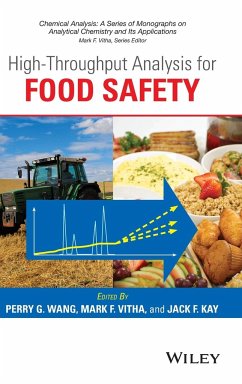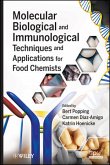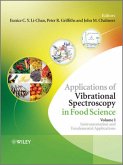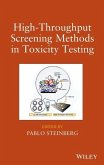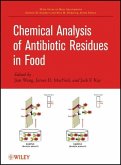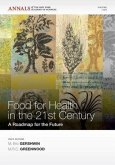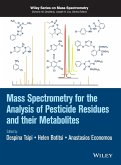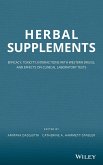High-Throughput Analysis for Food Safety
Herausgegeben von Wang, Perry G.; Vitha, Mark F.; Kay, Jack F.
High-Throughput Analysis for Food Safety
Herausgegeben von Wang, Perry G.; Vitha, Mark F.; Kay, Jack F.
- Gebundenes Buch
- Merkliste
- Auf die Merkliste
- Bewerten Bewerten
- Teilen
- Produkt teilen
- Produkterinnerung
- Produkterinnerung
This book focuses on high-throughput analyses for food safety. Because of the contributors domestic and international expertise from industry and government the book appeals to a wider audience. It includes the latest development in rapid screening, with a particular emphasis on the growing use and applicability of a variety of stand-alone mass spectrometry methods as well as using mass spectrometry in hyphenated techniques such as gas chromatograph mass spectrometry (GC-MS) and liquid chromatography mass spectrometry (LC-MS). Readers will be educated to the field of food safety and rapid…mehr
Andere Kunden interessierten sich auch für
![Molecular Biological and Immunological Techniques and Applications for Food Chemists Molecular Biological and Immunological Techniques and Applications for Food Chemists]() Molecular Biological and Immunological Techniques and Applications for Food Chemists164,99 €
Molecular Biological and Immunological Techniques and Applications for Food Chemists164,99 €![Applications of Vibrational Spectroscopy in Food Science, 2 Volume Set Applications of Vibrational Spectroscopy in Food Science, 2 Volume Set]() Applications of Vibrational Spectroscopy in Food Science, 2 Volume Set437,99 €
Applications of Vibrational Spectroscopy in Food Science, 2 Volume Set437,99 €![High-Throughput Screening Methods in Toxicity Testing High-Throughput Screening Methods in Toxicity Testing]() High-Throughput Screening Methods in Toxicity Testing169,99 €
High-Throughput Screening Methods in Toxicity Testing169,99 €![Chemical Analysis of Antibiotic Residues in Food Chemical Analysis of Antibiotic Residues in Food]() Chemical Analysis of Antibiotic Residues in Food131,99 €
Chemical Analysis of Antibiotic Residues in Food131,99 €![Foods for Health in the 21st Century Foods for Health in the 21st Century]() Foods for Health in the 21st Century137,99 €
Foods for Health in the 21st Century137,99 €![Mass Spectrometry for the Analysis of Pesticide Residues and their Metabolites Mass Spectrometry for the Analysis of Pesticide Residues and their Metabolites]() Despina TsipiMass Spectrometry for the Analysis of Pesticide Residues and their Metabolites132,99 €
Despina TsipiMass Spectrometry for the Analysis of Pesticide Residues and their Metabolites132,99 €![Herbal Supplements Herbal Supplements]() Herbal Supplements148,99 €
Herbal Supplements148,99 €-
-
-
This book focuses on high-throughput analyses for food safety. Because of the contributors domestic and international expertise from industry and government the book appeals to a wider audience. It includes the latest development in rapid screening, with a particular emphasis on the growing use and applicability of a variety of stand-alone mass spectrometry methods as well as using mass spectrometry in hyphenated techniques such as gas chromatograph mass spectrometry (GC-MS) and liquid chromatography mass spectrometry (LC-MS). Readers will be educated to the field of food safety and rapid testing in the most commonly used techniques.
Divided into three parts (Basics of High Throughput Analyses, Mass Spectrometry in High Throughput Analyses, and International Food Safety Testing) this book covers many important aspects of high-throughput analyses for food safety.
Divided into three parts (Basics of High Throughput Analyses, Mass Spectrometry in High Throughput Analyses, and International Food Safety Testing) this book covers many important aspects of high-throughput analyses for food safety.
Produktdetails
- Produktdetails
- Chemical Analysis: A Series of Monographs on Analytical Chemistry and Its Applications
- Verlag: Wiley & Sons
- 1. Auflage
- Seitenzahl: 298
- Erscheinungstermin: 22. September 2014
- Englisch
- Abmessung: 240mm x 161mm x 21mm
- Gewicht: 639g
- ISBN-13: 9781118396308
- ISBN-10: 1118396308
- Artikelnr.: 40190789
- Herstellerkennzeichnung
- Libri GmbH
- Europaallee 1
- 36244 Bad Hersfeld
- gpsr@libri.de
- Chemical Analysis: A Series of Monographs on Analytical Chemistry and Its Applications
- Verlag: Wiley & Sons
- 1. Auflage
- Seitenzahl: 298
- Erscheinungstermin: 22. September 2014
- Englisch
- Abmessung: 240mm x 161mm x 21mm
- Gewicht: 639g
- ISBN-13: 9781118396308
- ISBN-10: 1118396308
- Artikelnr.: 40190789
- Herstellerkennzeichnung
- Libri GmbH
- Europaallee 1
- 36244 Bad Hersfeld
- gpsr@libri.de
PERRY G. WANG, PHD, is a research chemist in the Office of Regulatory Science, CFSAN, US FDA. Prior to joining the FDA, Dr. Wang worked in the pharmaceutical and medical device industries. His expertise in the pharmaceutical field focuses on high-throughput drug analysis by LC-MS/MS. His current research at the FDA includes developing analytical methods for chemical ingredients in cosmetics and personal care products by GC-MS/MS and LC-MS/MS. This book is edited in his private capacity but not as an employee of the FDA. MARK F. VITHA, PHD, is a professor at Drake University. He is the editor of The Chemical Analysis Series (Wiley) and the co-editor of Interfaces and Interphases in Analytical Chemistry. In 2011, he was awarded the Windsor Professor of Science and the Ronald D. Troyer Research Fellowship. JOHN F. KAY, PHD, is a chemist and recently retired as the R&D manager at the UK Veterinary Medicines Directorate. For almost 20 years he actively participated in the Codex Alimentarius Committee on Residues of Veterinary Drugs in Food and remains on the JECFA expert roster 2012-2016 for veterinary drug residues. He has held an Honorary Senior Research Fellowship in the Department of Mathematics and Statistics at the University of Strathclyde, Scotland since 2005.
Preface xi
Contributors xiii
Chapter 1 Introduction: Basic Principles of Assays to be Covered, Sample
Handling, And Sample Processing 1
Wanlong Zhou, Eugene Y. Chang, and Perry G. Wang
1.1 Introduction 1
1.1.1 Current Situation and Challenges of Food Safety and Regulations 1
1.1.2 Residues and Matrices of Food Analysis and High-Throughput Analysis 2
1.1.3 Food Safety Classifications 3
1.1.4 "High Throughput" Definition 3
1.1.5 Scope of the Book 4
1.2 Advanced Sample Preparation Techniques 5
1.2.1 Automation of Weighing and Preparing Standard Solutions 5
1.2.2 QuEChERS 6
1.2.3 Swedish Extraction Technique (SweEt) and Other Fast Sample
Preparation Methods 6
1.2.4 Turbulent Flow Chromatography 7
1.2.5 Pressurized Liquid Extraction 7
1.2.6 Automated 96- and 384-Well Formatted Sample Preparation as well as
Automated SPE Workstations 8
1.2.7 Solid-Phase Microextraction 8
1.2.8 Microextraction by Packed Sorbent 9
1.2.9 Liquid Extraction Surface Analysis 9
1.2.10 Headspace GC 10
1.2.11 Summary 10
1.3 Future Perspectives 10
Acknowledgment 11
References 11
Chapter 2 Survey Of Mass Spectrometry-Based High-Throughput Methods In Food
Analysis 15
Lukas Vaclavik, Tomas Cajka, Wanlong Zhou, and Perry G. Wang
2.1 Introduction 15
2.2 Techniques Employing Chromatographic Separation 15
2.2.1 Gas Chromatography-Mass Spectrometry 15
2.2.2 Liquid Chromatography-Mass Spectrometry 21
2.3 Direct Techniques 30
2.3.1 Matrix-Assisted Laser Desorption/Ionization-Mass Spectrometry 30
2.3.2 Headspace (Solid-Phase Microextraction)-Mass Spectrometry E-Nose 37
2.3.3 Ambient Desorption/Ionization-Mass Spectrometry 38
2.4 Concluding Remarks 62
Acknowledgments 62
References 63
Chapter 3 Quality Systems, Quality Control Guidelines and Standards, Method
Validation, and Ongoing Analytical Quality Control 73
David Galsworthy and Stewart Reynolds
3.1 Introduction 73
3.1.1 Quality System Design 73
3.1.2 Procedures 74
3.1.3 Roles and Responsibilities 74
3.1.4 Quality Manual 74
3.1.5 Document Control 74
3.1.6 Control of Records 75
3.1.7 Audits 75
3.1.8 Validation of Methodology 75
3.1.9 Staff Competency 75
3.1.10 Internal Quality Control 76
3.1.11 Method Performance Criteria 76
3.2 Qualitative Screening Methods 76
3.2.1 Selectivity of Mass Spectrometry-Based Methods 78
3.2.2 Confirmatory Methods 78
3.2.3 Validation of Qualitative Screening Multiresidue Methods for
Pesticide Residues in Foods 79
3.3 Elements of the Analytical Workflow 80
3.3.1 Sample Preparation 80
3.3.2 Effects of Sample Processing 81
3.3.3 Extraction Efficiency 81
3.4 Initial Method Validation 81
3.5 Ongoing Analytical Quality Control 86
3.5.1 Internal Quality Control 86
3.5.2 Proficiency Testing 86
3.6 Validation of Qualitative Screening Multiresidue Methods for Veterinary
Drug Residues in Foods 87
3.6.1 EU Legislation Covering Method Validation for Veterinary Drug
Screening 87
3.6.2 Determination of Specificity/Selectivity and Detection Capability (CC
ß) Using the Classical Approach 88
3.6.3 Establishment of a Cutoff Level and Calculation of CCß 88
3.6.4 Determination of the Applicability 89
3.7 Conclusions 90
References 90
Chapter 4 Deliberate Chemical Contamination and Processing Contamination 93
Stephen Lock
4.1 Introduction 93
4.2 Heat-Induced Food Processing Contaminants 97
4.3 Packaging Migrants 101
4.4 Malicious Contamination of Food 105
References 111
Chapter 5 Multiresidual Determination Of 295 Pesticides And Chemical
Pollutants In Animal Fat By Gel Permeation Chromatography (Gpc) Cleanup
Coupled With Gc-Ms/Ms, Gc-Nci-Ms, And Lc-Ms/Ms 117
Yan-Zhong Cao, Yong-Ming Liu, Na Wang, Xin-Xin Ji, Cui-Cui Yao, Xiang Li,
Li-Li Shi, Qiao-Ying Chang, Chun-Lin Fan, and Guo-Fang Pang
5.1 Introduction 117
5.1.1 Persistent Organic Pollutants 118
5.1.2 Polycyclic Aromatic Hydrocarbons 119
5.1.3 Polychlorinated Biphenyls 119
5.1.4 Phthalate Esters 120
5.1.5 Multiclass and Multiresidue Analyses 120
5.2 Experiment 122
5.2.1 Instruments 122
5.2.2 Reagents 122
5.2.3 Preparation of Standard Solutions 122
5.2.4 Sample Preparation 123
5.2.5 Analytical Methods 124
5.2.6 Qualitative and Quantitative Determination 136
5.3 Results and Discussion 136
5.3.1 Selection of GPC Cleanup Conditions 136
5.3.2 Selection of Extraction Solvent 138
5.3.3 Comparison of Sample Extraction Methods 150
5.3.4 Comparison of Sample Cleanup 151
5.3.5 Linear Range, LOD, and LOQ 152
5.3.6 Recoveries and Precisions 152
5.3.7 Actual Sample Analysis 157
5.4 Conclusions 161
References 162
Chapter 6 Ultrahigh-Performance Liquid Chromatography Coupled With
High-Resolution Mass Spectrometry: A Reliable Tool For Analysis Of
Veterinary Drugs In Food 167
María del Mar Aguilera-Luiz, Roberto Romero-González,Patricia
Plaza-Bolaños, José Luis Martínez Vidal,and Antonia Garrido Frenich
6.1 Introduction 167
6.2 Veterinary Drug Legislation 168
6.3 Analytical Techniques for VD Residue Analysis 172
6.3.1 Chromatographic Separation 174
6.3.2 High-Resolution Mass Spectrometers 175
6.4 Food Control Applications 181
6.4.1 Screening Applications 181
6.4.2 Confirmation and Quantification Methods 191
6.4.3 Comparison Studies 195
6.5 Conclusions and Future Trends 201
Acknowledgments 202
References 203
Chapter 7 A Role For High-Resolution Mass Spectrometry In The
High-Throughput Analysis And Identification Of Veterinary Medicinal Product
Residues And Of Their Metabolites In Foods Of Animal Origin 213
Eric Verdon, Dominique Hurtaud-Pessel,and Jagadeshwar-Reddy Thota
7.1 Introduction 213
7.2 Issues Associated with Veterinary Drug Residues and European
Regulations 215
7.3 Choosing a Strategy: Targeted or Nontargeted Analysis? 216
7.3.1 Targeted Analysis Using HRMS 218
7.3.2 Nontargeted Analysis Using HRMS: Screening for Unknown Compounds 219
7.4 Application Number 1: Identification of Brilliant Green and its
Metabolites in Fish under High-Resolution Mass Spectral Conditions
(Targeted and Nontargeted Approaches) 220
7.5 Application Number 2: Targeted and Nontargeted Screening Approaches for
the Identification of Antimicrobial Residues in Meat 223
7.6 Conclusions 227
References 227
Chapter 8 High-Throughput Analysis of Mycotoxins 231
Marta Vaclavikova, Lukas Vaclavik, and Tomas Cajka
8.1 Introduction 231
8.1.1 Legislation and Regulatory Limits 231
8.1.2 Emerging Mycotoxins 237
8.1.3 Analysis of Mycotoxins in the High-Throughput Environment 238
8.2 Sample Preparation 239
8.2.1 Sampling 240
8.2.2 Matrices of Interest 240
8.2.3 Extraction of Mycotoxins 241
8.2.4 Purification of Sample Extracts 246
8.3 Separation and Detection of Mycotoxins 247
8.3.1 Liquid Chromatography-Mass Spectrometry-Based Methods 248
8.3.2 High-Resolution Mass Spectrometry in Mycotoxins Analysis 250
8.4 No-Separation Mass Spectrometry-Based Methods 252
8.4.1 Matrix-Assisted Laser Desorption Ionization-Mass Spectrometry 252
8.4.2 Ambient Ionization Mass Spectrometry 253
8.4.3 Ion Mobility Spectrometry 254
8.4.4 Immunochemical Methods 256
8.5 Conclusions 259
Acknowledgments 259
References 259
Index 267
Contributors xiii
Chapter 1 Introduction: Basic Principles of Assays to be Covered, Sample
Handling, And Sample Processing 1
Wanlong Zhou, Eugene Y. Chang, and Perry G. Wang
1.1 Introduction 1
1.1.1 Current Situation and Challenges of Food Safety and Regulations 1
1.1.2 Residues and Matrices of Food Analysis and High-Throughput Analysis 2
1.1.3 Food Safety Classifications 3
1.1.4 "High Throughput" Definition 3
1.1.5 Scope of the Book 4
1.2 Advanced Sample Preparation Techniques 5
1.2.1 Automation of Weighing and Preparing Standard Solutions 5
1.2.2 QuEChERS 6
1.2.3 Swedish Extraction Technique (SweEt) and Other Fast Sample
Preparation Methods 6
1.2.4 Turbulent Flow Chromatography 7
1.2.5 Pressurized Liquid Extraction 7
1.2.6 Automated 96- and 384-Well Formatted Sample Preparation as well as
Automated SPE Workstations 8
1.2.7 Solid-Phase Microextraction 8
1.2.8 Microextraction by Packed Sorbent 9
1.2.9 Liquid Extraction Surface Analysis 9
1.2.10 Headspace GC 10
1.2.11 Summary 10
1.3 Future Perspectives 10
Acknowledgment 11
References 11
Chapter 2 Survey Of Mass Spectrometry-Based High-Throughput Methods In Food
Analysis 15
Lukas Vaclavik, Tomas Cajka, Wanlong Zhou, and Perry G. Wang
2.1 Introduction 15
2.2 Techniques Employing Chromatographic Separation 15
2.2.1 Gas Chromatography-Mass Spectrometry 15
2.2.2 Liquid Chromatography-Mass Spectrometry 21
2.3 Direct Techniques 30
2.3.1 Matrix-Assisted Laser Desorption/Ionization-Mass Spectrometry 30
2.3.2 Headspace (Solid-Phase Microextraction)-Mass Spectrometry E-Nose 37
2.3.3 Ambient Desorption/Ionization-Mass Spectrometry 38
2.4 Concluding Remarks 62
Acknowledgments 62
References 63
Chapter 3 Quality Systems, Quality Control Guidelines and Standards, Method
Validation, and Ongoing Analytical Quality Control 73
David Galsworthy and Stewart Reynolds
3.1 Introduction 73
3.1.1 Quality System Design 73
3.1.2 Procedures 74
3.1.3 Roles and Responsibilities 74
3.1.4 Quality Manual 74
3.1.5 Document Control 74
3.1.6 Control of Records 75
3.1.7 Audits 75
3.1.8 Validation of Methodology 75
3.1.9 Staff Competency 75
3.1.10 Internal Quality Control 76
3.1.11 Method Performance Criteria 76
3.2 Qualitative Screening Methods 76
3.2.1 Selectivity of Mass Spectrometry-Based Methods 78
3.2.2 Confirmatory Methods 78
3.2.3 Validation of Qualitative Screening Multiresidue Methods for
Pesticide Residues in Foods 79
3.3 Elements of the Analytical Workflow 80
3.3.1 Sample Preparation 80
3.3.2 Effects of Sample Processing 81
3.3.3 Extraction Efficiency 81
3.4 Initial Method Validation 81
3.5 Ongoing Analytical Quality Control 86
3.5.1 Internal Quality Control 86
3.5.2 Proficiency Testing 86
3.6 Validation of Qualitative Screening Multiresidue Methods for Veterinary
Drug Residues in Foods 87
3.6.1 EU Legislation Covering Method Validation for Veterinary Drug
Screening 87
3.6.2 Determination of Specificity/Selectivity and Detection Capability (CC
ß) Using the Classical Approach 88
3.6.3 Establishment of a Cutoff Level and Calculation of CCß 88
3.6.4 Determination of the Applicability 89
3.7 Conclusions 90
References 90
Chapter 4 Deliberate Chemical Contamination and Processing Contamination 93
Stephen Lock
4.1 Introduction 93
4.2 Heat-Induced Food Processing Contaminants 97
4.3 Packaging Migrants 101
4.4 Malicious Contamination of Food 105
References 111
Chapter 5 Multiresidual Determination Of 295 Pesticides And Chemical
Pollutants In Animal Fat By Gel Permeation Chromatography (Gpc) Cleanup
Coupled With Gc-Ms/Ms, Gc-Nci-Ms, And Lc-Ms/Ms 117
Yan-Zhong Cao, Yong-Ming Liu, Na Wang, Xin-Xin Ji, Cui-Cui Yao, Xiang Li,
Li-Li Shi, Qiao-Ying Chang, Chun-Lin Fan, and Guo-Fang Pang
5.1 Introduction 117
5.1.1 Persistent Organic Pollutants 118
5.1.2 Polycyclic Aromatic Hydrocarbons 119
5.1.3 Polychlorinated Biphenyls 119
5.1.4 Phthalate Esters 120
5.1.5 Multiclass and Multiresidue Analyses 120
5.2 Experiment 122
5.2.1 Instruments 122
5.2.2 Reagents 122
5.2.3 Preparation of Standard Solutions 122
5.2.4 Sample Preparation 123
5.2.5 Analytical Methods 124
5.2.6 Qualitative and Quantitative Determination 136
5.3 Results and Discussion 136
5.3.1 Selection of GPC Cleanup Conditions 136
5.3.2 Selection of Extraction Solvent 138
5.3.3 Comparison of Sample Extraction Methods 150
5.3.4 Comparison of Sample Cleanup 151
5.3.5 Linear Range, LOD, and LOQ 152
5.3.6 Recoveries and Precisions 152
5.3.7 Actual Sample Analysis 157
5.4 Conclusions 161
References 162
Chapter 6 Ultrahigh-Performance Liquid Chromatography Coupled With
High-Resolution Mass Spectrometry: A Reliable Tool For Analysis Of
Veterinary Drugs In Food 167
María del Mar Aguilera-Luiz, Roberto Romero-González,Patricia
Plaza-Bolaños, José Luis Martínez Vidal,and Antonia Garrido Frenich
6.1 Introduction 167
6.2 Veterinary Drug Legislation 168
6.3 Analytical Techniques for VD Residue Analysis 172
6.3.1 Chromatographic Separation 174
6.3.2 High-Resolution Mass Spectrometers 175
6.4 Food Control Applications 181
6.4.1 Screening Applications 181
6.4.2 Confirmation and Quantification Methods 191
6.4.3 Comparison Studies 195
6.5 Conclusions and Future Trends 201
Acknowledgments 202
References 203
Chapter 7 A Role For High-Resolution Mass Spectrometry In The
High-Throughput Analysis And Identification Of Veterinary Medicinal Product
Residues And Of Their Metabolites In Foods Of Animal Origin 213
Eric Verdon, Dominique Hurtaud-Pessel,and Jagadeshwar-Reddy Thota
7.1 Introduction 213
7.2 Issues Associated with Veterinary Drug Residues and European
Regulations 215
7.3 Choosing a Strategy: Targeted or Nontargeted Analysis? 216
7.3.1 Targeted Analysis Using HRMS 218
7.3.2 Nontargeted Analysis Using HRMS: Screening for Unknown Compounds 219
7.4 Application Number 1: Identification of Brilliant Green and its
Metabolites in Fish under High-Resolution Mass Spectral Conditions
(Targeted and Nontargeted Approaches) 220
7.5 Application Number 2: Targeted and Nontargeted Screening Approaches for
the Identification of Antimicrobial Residues in Meat 223
7.6 Conclusions 227
References 227
Chapter 8 High-Throughput Analysis of Mycotoxins 231
Marta Vaclavikova, Lukas Vaclavik, and Tomas Cajka
8.1 Introduction 231
8.1.1 Legislation and Regulatory Limits 231
8.1.2 Emerging Mycotoxins 237
8.1.3 Analysis of Mycotoxins in the High-Throughput Environment 238
8.2 Sample Preparation 239
8.2.1 Sampling 240
8.2.2 Matrices of Interest 240
8.2.3 Extraction of Mycotoxins 241
8.2.4 Purification of Sample Extracts 246
8.3 Separation and Detection of Mycotoxins 247
8.3.1 Liquid Chromatography-Mass Spectrometry-Based Methods 248
8.3.2 High-Resolution Mass Spectrometry in Mycotoxins Analysis 250
8.4 No-Separation Mass Spectrometry-Based Methods 252
8.4.1 Matrix-Assisted Laser Desorption Ionization-Mass Spectrometry 252
8.4.2 Ambient Ionization Mass Spectrometry 253
8.4.3 Ion Mobility Spectrometry 254
8.4.4 Immunochemical Methods 256
8.5 Conclusions 259
Acknowledgments 259
References 259
Index 267
Preface xi
Contributors xiii
Chapter 1 Introduction: Basic Principles of Assays to be Covered, Sample
Handling, And Sample Processing 1
Wanlong Zhou, Eugene Y. Chang, and Perry G. Wang
1.1 Introduction 1
1.1.1 Current Situation and Challenges of Food Safety and Regulations 1
1.1.2 Residues and Matrices of Food Analysis and High-Throughput Analysis 2
1.1.3 Food Safety Classifications 3
1.1.4 "High Throughput" Definition 3
1.1.5 Scope of the Book 4
1.2 Advanced Sample Preparation Techniques 5
1.2.1 Automation of Weighing and Preparing Standard Solutions 5
1.2.2 QuEChERS 6
1.2.3 Swedish Extraction Technique (SweEt) and Other Fast Sample
Preparation Methods 6
1.2.4 Turbulent Flow Chromatography 7
1.2.5 Pressurized Liquid Extraction 7
1.2.6 Automated 96- and 384-Well Formatted Sample Preparation as well as
Automated SPE Workstations 8
1.2.7 Solid-Phase Microextraction 8
1.2.8 Microextraction by Packed Sorbent 9
1.2.9 Liquid Extraction Surface Analysis 9
1.2.10 Headspace GC 10
1.2.11 Summary 10
1.3 Future Perspectives 10
Acknowledgment 11
References 11
Chapter 2 Survey Of Mass Spectrometry-Based High-Throughput Methods In Food
Analysis 15
Lukas Vaclavik, Tomas Cajka, Wanlong Zhou, and Perry G. Wang
2.1 Introduction 15
2.2 Techniques Employing Chromatographic Separation 15
2.2.1 Gas Chromatography-Mass Spectrometry 15
2.2.2 Liquid Chromatography-Mass Spectrometry 21
2.3 Direct Techniques 30
2.3.1 Matrix-Assisted Laser Desorption/Ionization-Mass Spectrometry 30
2.3.2 Headspace (Solid-Phase Microextraction)-Mass Spectrometry E-Nose 37
2.3.3 Ambient Desorption/Ionization-Mass Spectrometry 38
2.4 Concluding Remarks 62
Acknowledgments 62
References 63
Chapter 3 Quality Systems, Quality Control Guidelines and Standards, Method
Validation, and Ongoing Analytical Quality Control 73
David Galsworthy and Stewart Reynolds
3.1 Introduction 73
3.1.1 Quality System Design 73
3.1.2 Procedures 74
3.1.3 Roles and Responsibilities 74
3.1.4 Quality Manual 74
3.1.5 Document Control 74
3.1.6 Control of Records 75
3.1.7 Audits 75
3.1.8 Validation of Methodology 75
3.1.9 Staff Competency 75
3.1.10 Internal Quality Control 76
3.1.11 Method Performance Criteria 76
3.2 Qualitative Screening Methods 76
3.2.1 Selectivity of Mass Spectrometry-Based Methods 78
3.2.2 Confirmatory Methods 78
3.2.3 Validation of Qualitative Screening Multiresidue Methods for
Pesticide Residues in Foods 79
3.3 Elements of the Analytical Workflow 80
3.3.1 Sample Preparation 80
3.3.2 Effects of Sample Processing 81
3.3.3 Extraction Efficiency 81
3.4 Initial Method Validation 81
3.5 Ongoing Analytical Quality Control 86
3.5.1 Internal Quality Control 86
3.5.2 Proficiency Testing 86
3.6 Validation of Qualitative Screening Multiresidue Methods for Veterinary
Drug Residues in Foods 87
3.6.1 EU Legislation Covering Method Validation for Veterinary Drug
Screening 87
3.6.2 Determination of Specificity/Selectivity and Detection Capability (CC
ß) Using the Classical Approach 88
3.6.3 Establishment of a Cutoff Level and Calculation of CCß 88
3.6.4 Determination of the Applicability 89
3.7 Conclusions 90
References 90
Chapter 4 Deliberate Chemical Contamination and Processing Contamination 93
Stephen Lock
4.1 Introduction 93
4.2 Heat-Induced Food Processing Contaminants 97
4.3 Packaging Migrants 101
4.4 Malicious Contamination of Food 105
References 111
Chapter 5 Multiresidual Determination Of 295 Pesticides And Chemical
Pollutants In Animal Fat By Gel Permeation Chromatography (Gpc) Cleanup
Coupled With Gc-Ms/Ms, Gc-Nci-Ms, And Lc-Ms/Ms 117
Yan-Zhong Cao, Yong-Ming Liu, Na Wang, Xin-Xin Ji, Cui-Cui Yao, Xiang Li,
Li-Li Shi, Qiao-Ying Chang, Chun-Lin Fan, and Guo-Fang Pang
5.1 Introduction 117
5.1.1 Persistent Organic Pollutants 118
5.1.2 Polycyclic Aromatic Hydrocarbons 119
5.1.3 Polychlorinated Biphenyls 119
5.1.4 Phthalate Esters 120
5.1.5 Multiclass and Multiresidue Analyses 120
5.2 Experiment 122
5.2.1 Instruments 122
5.2.2 Reagents 122
5.2.3 Preparation of Standard Solutions 122
5.2.4 Sample Preparation 123
5.2.5 Analytical Methods 124
5.2.6 Qualitative and Quantitative Determination 136
5.3 Results and Discussion 136
5.3.1 Selection of GPC Cleanup Conditions 136
5.3.2 Selection of Extraction Solvent 138
5.3.3 Comparison of Sample Extraction Methods 150
5.3.4 Comparison of Sample Cleanup 151
5.3.5 Linear Range, LOD, and LOQ 152
5.3.6 Recoveries and Precisions 152
5.3.7 Actual Sample Analysis 157
5.4 Conclusions 161
References 162
Chapter 6 Ultrahigh-Performance Liquid Chromatography Coupled With
High-Resolution Mass Spectrometry: A Reliable Tool For Analysis Of
Veterinary Drugs In Food 167
María del Mar Aguilera-Luiz, Roberto Romero-González,Patricia
Plaza-Bolaños, José Luis Martínez Vidal,and Antonia Garrido Frenich
6.1 Introduction 167
6.2 Veterinary Drug Legislation 168
6.3 Analytical Techniques for VD Residue Analysis 172
6.3.1 Chromatographic Separation 174
6.3.2 High-Resolution Mass Spectrometers 175
6.4 Food Control Applications 181
6.4.1 Screening Applications 181
6.4.2 Confirmation and Quantification Methods 191
6.4.3 Comparison Studies 195
6.5 Conclusions and Future Trends 201
Acknowledgments 202
References 203
Chapter 7 A Role For High-Resolution Mass Spectrometry In The
High-Throughput Analysis And Identification Of Veterinary Medicinal Product
Residues And Of Their Metabolites In Foods Of Animal Origin 213
Eric Verdon, Dominique Hurtaud-Pessel,and Jagadeshwar-Reddy Thota
7.1 Introduction 213
7.2 Issues Associated with Veterinary Drug Residues and European
Regulations 215
7.3 Choosing a Strategy: Targeted or Nontargeted Analysis? 216
7.3.1 Targeted Analysis Using HRMS 218
7.3.2 Nontargeted Analysis Using HRMS: Screening for Unknown Compounds 219
7.4 Application Number 1: Identification of Brilliant Green and its
Metabolites in Fish under High-Resolution Mass Spectral Conditions
(Targeted and Nontargeted Approaches) 220
7.5 Application Number 2: Targeted and Nontargeted Screening Approaches for
the Identification of Antimicrobial Residues in Meat 223
7.6 Conclusions 227
References 227
Chapter 8 High-Throughput Analysis of Mycotoxins 231
Marta Vaclavikova, Lukas Vaclavik, and Tomas Cajka
8.1 Introduction 231
8.1.1 Legislation and Regulatory Limits 231
8.1.2 Emerging Mycotoxins 237
8.1.3 Analysis of Mycotoxins in the High-Throughput Environment 238
8.2 Sample Preparation 239
8.2.1 Sampling 240
8.2.2 Matrices of Interest 240
8.2.3 Extraction of Mycotoxins 241
8.2.4 Purification of Sample Extracts 246
8.3 Separation and Detection of Mycotoxins 247
8.3.1 Liquid Chromatography-Mass Spectrometry-Based Methods 248
8.3.2 High-Resolution Mass Spectrometry in Mycotoxins Analysis 250
8.4 No-Separation Mass Spectrometry-Based Methods 252
8.4.1 Matrix-Assisted Laser Desorption Ionization-Mass Spectrometry 252
8.4.2 Ambient Ionization Mass Spectrometry 253
8.4.3 Ion Mobility Spectrometry 254
8.4.4 Immunochemical Methods 256
8.5 Conclusions 259
Acknowledgments 259
References 259
Index 267
Contributors xiii
Chapter 1 Introduction: Basic Principles of Assays to be Covered, Sample
Handling, And Sample Processing 1
Wanlong Zhou, Eugene Y. Chang, and Perry G. Wang
1.1 Introduction 1
1.1.1 Current Situation and Challenges of Food Safety and Regulations 1
1.1.2 Residues and Matrices of Food Analysis and High-Throughput Analysis 2
1.1.3 Food Safety Classifications 3
1.1.4 "High Throughput" Definition 3
1.1.5 Scope of the Book 4
1.2 Advanced Sample Preparation Techniques 5
1.2.1 Automation of Weighing and Preparing Standard Solutions 5
1.2.2 QuEChERS 6
1.2.3 Swedish Extraction Technique (SweEt) and Other Fast Sample
Preparation Methods 6
1.2.4 Turbulent Flow Chromatography 7
1.2.5 Pressurized Liquid Extraction 7
1.2.6 Automated 96- and 384-Well Formatted Sample Preparation as well as
Automated SPE Workstations 8
1.2.7 Solid-Phase Microextraction 8
1.2.8 Microextraction by Packed Sorbent 9
1.2.9 Liquid Extraction Surface Analysis 9
1.2.10 Headspace GC 10
1.2.11 Summary 10
1.3 Future Perspectives 10
Acknowledgment 11
References 11
Chapter 2 Survey Of Mass Spectrometry-Based High-Throughput Methods In Food
Analysis 15
Lukas Vaclavik, Tomas Cajka, Wanlong Zhou, and Perry G. Wang
2.1 Introduction 15
2.2 Techniques Employing Chromatographic Separation 15
2.2.1 Gas Chromatography-Mass Spectrometry 15
2.2.2 Liquid Chromatography-Mass Spectrometry 21
2.3 Direct Techniques 30
2.3.1 Matrix-Assisted Laser Desorption/Ionization-Mass Spectrometry 30
2.3.2 Headspace (Solid-Phase Microextraction)-Mass Spectrometry E-Nose 37
2.3.3 Ambient Desorption/Ionization-Mass Spectrometry 38
2.4 Concluding Remarks 62
Acknowledgments 62
References 63
Chapter 3 Quality Systems, Quality Control Guidelines and Standards, Method
Validation, and Ongoing Analytical Quality Control 73
David Galsworthy and Stewart Reynolds
3.1 Introduction 73
3.1.1 Quality System Design 73
3.1.2 Procedures 74
3.1.3 Roles and Responsibilities 74
3.1.4 Quality Manual 74
3.1.5 Document Control 74
3.1.6 Control of Records 75
3.1.7 Audits 75
3.1.8 Validation of Methodology 75
3.1.9 Staff Competency 75
3.1.10 Internal Quality Control 76
3.1.11 Method Performance Criteria 76
3.2 Qualitative Screening Methods 76
3.2.1 Selectivity of Mass Spectrometry-Based Methods 78
3.2.2 Confirmatory Methods 78
3.2.3 Validation of Qualitative Screening Multiresidue Methods for
Pesticide Residues in Foods 79
3.3 Elements of the Analytical Workflow 80
3.3.1 Sample Preparation 80
3.3.2 Effects of Sample Processing 81
3.3.3 Extraction Efficiency 81
3.4 Initial Method Validation 81
3.5 Ongoing Analytical Quality Control 86
3.5.1 Internal Quality Control 86
3.5.2 Proficiency Testing 86
3.6 Validation of Qualitative Screening Multiresidue Methods for Veterinary
Drug Residues in Foods 87
3.6.1 EU Legislation Covering Method Validation for Veterinary Drug
Screening 87
3.6.2 Determination of Specificity/Selectivity and Detection Capability (CC
ß) Using the Classical Approach 88
3.6.3 Establishment of a Cutoff Level and Calculation of CCß 88
3.6.4 Determination of the Applicability 89
3.7 Conclusions 90
References 90
Chapter 4 Deliberate Chemical Contamination and Processing Contamination 93
Stephen Lock
4.1 Introduction 93
4.2 Heat-Induced Food Processing Contaminants 97
4.3 Packaging Migrants 101
4.4 Malicious Contamination of Food 105
References 111
Chapter 5 Multiresidual Determination Of 295 Pesticides And Chemical
Pollutants In Animal Fat By Gel Permeation Chromatography (Gpc) Cleanup
Coupled With Gc-Ms/Ms, Gc-Nci-Ms, And Lc-Ms/Ms 117
Yan-Zhong Cao, Yong-Ming Liu, Na Wang, Xin-Xin Ji, Cui-Cui Yao, Xiang Li,
Li-Li Shi, Qiao-Ying Chang, Chun-Lin Fan, and Guo-Fang Pang
5.1 Introduction 117
5.1.1 Persistent Organic Pollutants 118
5.1.2 Polycyclic Aromatic Hydrocarbons 119
5.1.3 Polychlorinated Biphenyls 119
5.1.4 Phthalate Esters 120
5.1.5 Multiclass and Multiresidue Analyses 120
5.2 Experiment 122
5.2.1 Instruments 122
5.2.2 Reagents 122
5.2.3 Preparation of Standard Solutions 122
5.2.4 Sample Preparation 123
5.2.5 Analytical Methods 124
5.2.6 Qualitative and Quantitative Determination 136
5.3 Results and Discussion 136
5.3.1 Selection of GPC Cleanup Conditions 136
5.3.2 Selection of Extraction Solvent 138
5.3.3 Comparison of Sample Extraction Methods 150
5.3.4 Comparison of Sample Cleanup 151
5.3.5 Linear Range, LOD, and LOQ 152
5.3.6 Recoveries and Precisions 152
5.3.7 Actual Sample Analysis 157
5.4 Conclusions 161
References 162
Chapter 6 Ultrahigh-Performance Liquid Chromatography Coupled With
High-Resolution Mass Spectrometry: A Reliable Tool For Analysis Of
Veterinary Drugs In Food 167
María del Mar Aguilera-Luiz, Roberto Romero-González,Patricia
Plaza-Bolaños, José Luis Martínez Vidal,and Antonia Garrido Frenich
6.1 Introduction 167
6.2 Veterinary Drug Legislation 168
6.3 Analytical Techniques for VD Residue Analysis 172
6.3.1 Chromatographic Separation 174
6.3.2 High-Resolution Mass Spectrometers 175
6.4 Food Control Applications 181
6.4.1 Screening Applications 181
6.4.2 Confirmation and Quantification Methods 191
6.4.3 Comparison Studies 195
6.5 Conclusions and Future Trends 201
Acknowledgments 202
References 203
Chapter 7 A Role For High-Resolution Mass Spectrometry In The
High-Throughput Analysis And Identification Of Veterinary Medicinal Product
Residues And Of Their Metabolites In Foods Of Animal Origin 213
Eric Verdon, Dominique Hurtaud-Pessel,and Jagadeshwar-Reddy Thota
7.1 Introduction 213
7.2 Issues Associated with Veterinary Drug Residues and European
Regulations 215
7.3 Choosing a Strategy: Targeted or Nontargeted Analysis? 216
7.3.1 Targeted Analysis Using HRMS 218
7.3.2 Nontargeted Analysis Using HRMS: Screening for Unknown Compounds 219
7.4 Application Number 1: Identification of Brilliant Green and its
Metabolites in Fish under High-Resolution Mass Spectral Conditions
(Targeted and Nontargeted Approaches) 220
7.5 Application Number 2: Targeted and Nontargeted Screening Approaches for
the Identification of Antimicrobial Residues in Meat 223
7.6 Conclusions 227
References 227
Chapter 8 High-Throughput Analysis of Mycotoxins 231
Marta Vaclavikova, Lukas Vaclavik, and Tomas Cajka
8.1 Introduction 231
8.1.1 Legislation and Regulatory Limits 231
8.1.2 Emerging Mycotoxins 237
8.1.3 Analysis of Mycotoxins in the High-Throughput Environment 238
8.2 Sample Preparation 239
8.2.1 Sampling 240
8.2.2 Matrices of Interest 240
8.2.3 Extraction of Mycotoxins 241
8.2.4 Purification of Sample Extracts 246
8.3 Separation and Detection of Mycotoxins 247
8.3.1 Liquid Chromatography-Mass Spectrometry-Based Methods 248
8.3.2 High-Resolution Mass Spectrometry in Mycotoxins Analysis 250
8.4 No-Separation Mass Spectrometry-Based Methods 252
8.4.1 Matrix-Assisted Laser Desorption Ionization-Mass Spectrometry 252
8.4.2 Ambient Ionization Mass Spectrometry 253
8.4.3 Ion Mobility Spectrometry 254
8.4.4 Immunochemical Methods 256
8.5 Conclusions 259
Acknowledgments 259
References 259
Index 267

